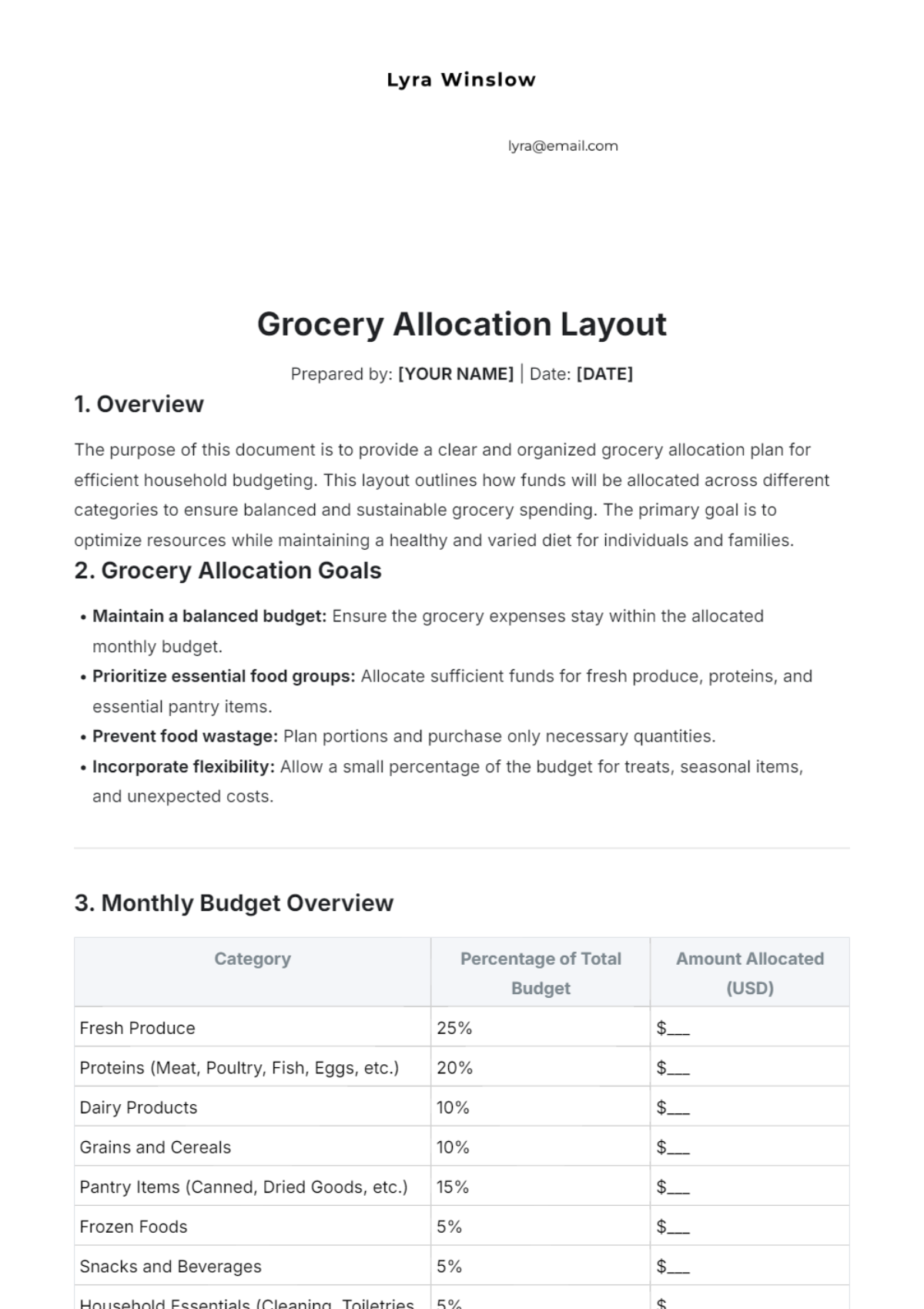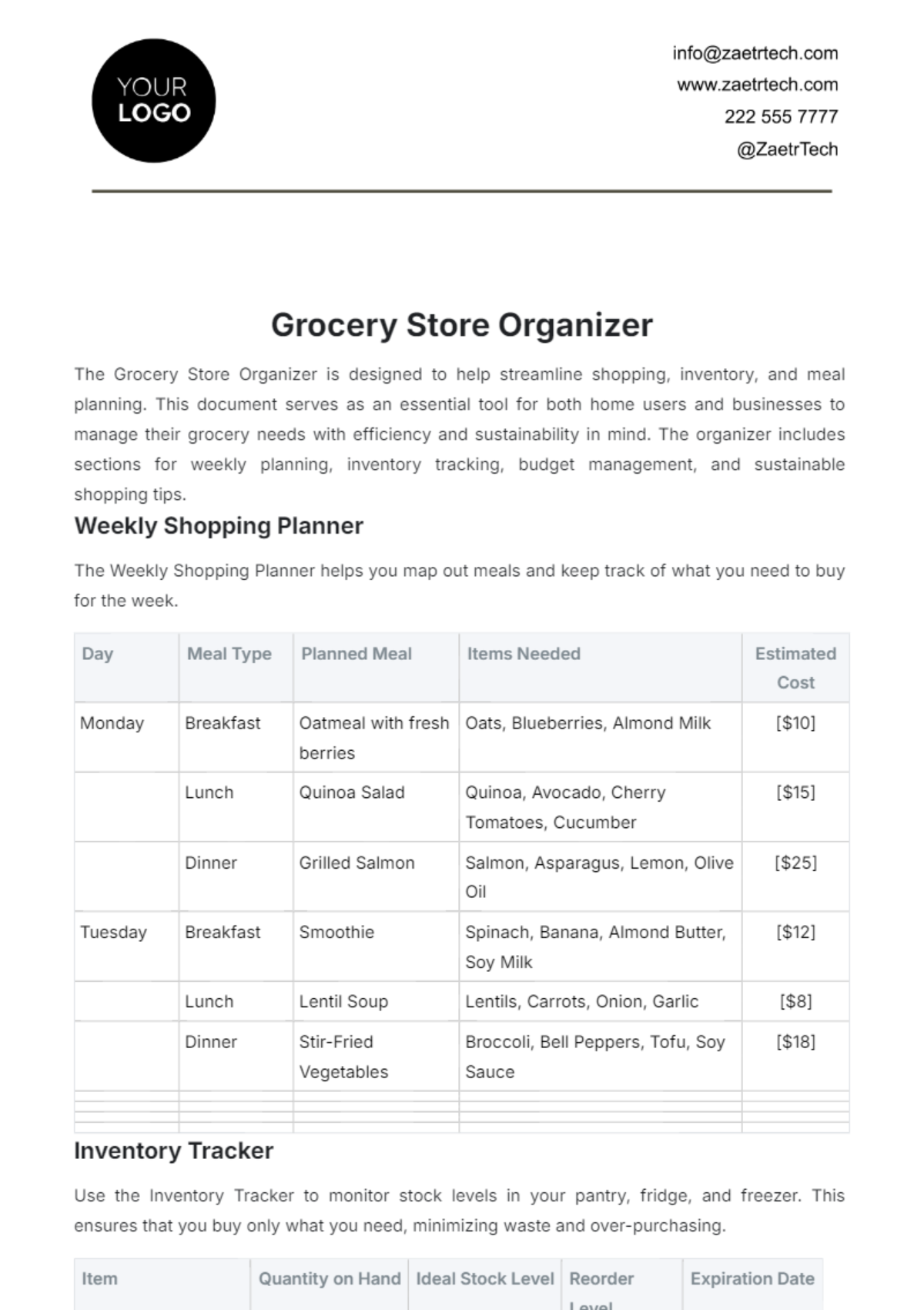Grocery Store Product Display SOP Layout
I. Introduction
A. Purpose
(Explain the overall purpose of the SOP. Mention how the guidelines will help ensure consistency, optimize sales, and improve the customer experience.)
B. Scope
(Define the scope of the SOP. Indicate which locations, departments, and employees it applies to.)
C. Responsibilities
(Detail the roles and responsibilities of different staff members involved in the product display process. Include managers, display team members, and any other relevant personnel.)
II. General Guidelines
A. Safety and Compliance
(Outline the safety standards and compliance regulations that must be adhered to when setting up displays. Include information on workplace safety, product handling, and any relevant legal requirements.)
B. Cleanliness and Organization
(Describe the importance of maintaining clean and organized display areas. Provide guidelines for regular cleaning schedules, clutter management, and presentation standards.)
III. Display Planning
A. Display Objectives
(Define the goals for product displays, such as increasing sales, promoting new products, or highlighting seasonal items. Explain how these objectives should influence display design.)
B. Target Audience
(Identify the target audience for different types of displays. Discuss how to tailor displays to appeal to specific customer segments based on demographics, shopping behavior, and preferences.)
C. Display Themes
(Provide guidance on choosing themes for displays. Discuss the importance of seasonal themes, promotional events, and brand-specific displays.)
IV. Display Setup
A. Location Selection
(Explain how to choose the best locations for displays within the store. Include criteria such as foot traffic, visibility, and proximity to related products.)
B. Product Selection
(Provide guidelines for selecting products to feature in displays. Consider factors such as popularity, profitability, and promotional priorities.)
C. Display Design
(Detail the principles of effective display design. Include information on color schemes, signage, lighting, and layout.)
D. Stocking and Restocking
(Describe the process for stocking and restocking displays. Include guidelines for maintaining product levels, rotating stock, and ensuring freshness.)
V. Execution
A. Assembly
(Provide step-by-step instructions for assembling displays. Include details on tools, materials, and techniques.)
B. Quality Check
(Outline the process for conducting quality checks on displays. Discuss the importance of inspecting for completeness, cleanliness, and adherence to design standards.)
C. Final Adjustments
(Explain how to make final adjustments to displays to ensure they are visually appealing and effective. Include tips for fine-tuning placement, lighting, and signage.)
VI. Maintenance
A. Daily Maintenance
(Provide guidelines for daily maintenance of displays. Include tasks such as dusting, straightening products, and checking for damage.)
B. Weekly Maintenance
(Detail the tasks required for weekly maintenance of displays. Include deep cleaning, stock rotation, and updating signage.)
C. Seasonal Adjustments
(Explain how to adjust displays for different seasons. Discuss the importance of refreshing displays to keep them relevant and engaging.)
VII. Evaluation
A. Sales Tracking
(Describe how to track sales performance of products featured in displays. Include methods for collecting data and analyzing results.)
B. Customer Feedback
(Provide guidelines for gathering and utilizing customer feedback on displays. Include techniques for soliciting input and using it to improve future displays.)
C. Performance Review
(Explain how to conduct regular performance reviews of displays. Discuss criteria for evaluation and the process for making improvements based on findings.)
VIII. Training
A. Training Programs
(Detail the training programs available for employees responsible for product displays. Include information on initial training, ongoing education, and certification requirements.)
B. Training Materials
(Describe the materials used in training programs. Include manuals, videos, workshops, and any other relevant resources.)
C. Assessment and Certification
(Explain the process for assessing employee competency in display setup and maintenance. Include details on certification requirements and renewal procedures.)
IX. Documentation
A. Record Keeping
(Provide guidelines for keeping records related to product displays. Include information on what records to keep, how to store them, and how long to retain them.)
B. Reporting
(Explain the reporting process for display-related activities. Include details on who should report, what should be reported, and how often reports should be submitted.)
C. Audits
(Describe the audit process for product displays. Include information on who conducts audits, what they should look for, and how often they should be performed.)
X. Appendices
A. Display Checklist
(Include a checklist that employees can use to ensure they have completed all necessary steps for setting up and maintaining displays.)
B. Sample Display Layouts
(Provide examples of effective display layouts. Include diagrams and photos to illustrate key concepts.)
C. Contact Information
(List contact information for key personnel involved in the display process. Include names, titles, phone numbers, and email addresses.)
XI. References
A. Internal Resources
(List any internal resources referenced in the SOP. Include policy documents, training materials, and other relevant resources.)
B. External Resources
(Include any external resources referenced in the SOP. These might include industry standards, regulatory guidelines, and best practice documents.)
XII. Review and Revision
A. Review Schedule
(Detail the schedule for reviewing and updating the SOP. Include information on how often reviews should take place and who is responsible for them.)
B. Revision History
(Provide a table or list documenting the history of revisions to the SOP. Include dates, descriptions of changes, and the names of those who made the changes.)
C. Approval Process
(Explain the process for approving revisions to the SOP. Include information on who needs to sign off on changes and how approvals are documented.)
























